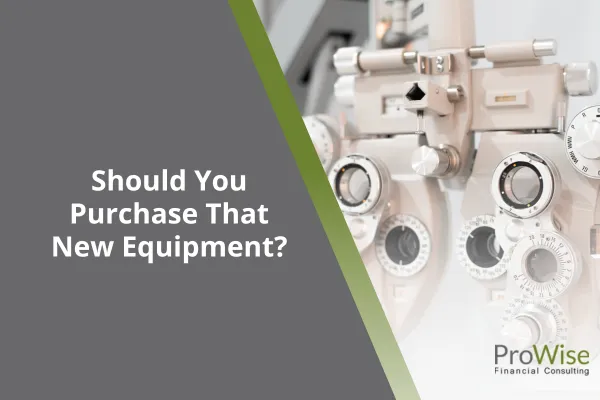
Should You Purchase that New Equipement?
The Smart Approach to Equipment Investment in Optometry: A Case Study with Dr. Ben
In the world of optometry, investing in new equipment can feel like a giant leap forward — promising better care for patients, improved efficiency for staff, and the potential for greater revenue. But every shiny new tool comes with a price tag, and that price must be weighed carefully against your practice’s real numbers.
Today, I want to share the story of one of our clients, Dr. Ben, who faced this very decision: whether to purchase a new $60,000 scanner for his growing practice.
The Exciting Opportunity — and a Crucial Question
When Dr. Ben came to us, he was excited about this new piece of equipment. It would deliver faster results, offer greater reliability, and open the door to billing for additional tests. On paper, it sounded like a no-brainer.
But Dr. Ben asked the right question:
“Is this investment truly worth it — right now?”
The answer depended not just on the scanner’s capabilities, but on how it would impact his practice’s financial efficiency.
Using a Hidden Cash Analysis to See the Full Picture
We started by conducting a Hidden Cash Analysis, which goes beyond just looking at your P&L or cash flow. One of the key metrics we reviewed was Dr. Ben’s Sales to Assets Ratio — a powerful indicator of how efficiently a practice turns its assets (like equipment) into revenue.
In optometry, the industry benchmark for this ratio is about 4.5 — meaning for every dollar invested in equipment and other fixed assets, the practice should generate $4.50 in revenue.
At the time, Dr. Ben’s ratio was 2.9 — well below the benchmark.
If he added the new scanner to his balance sheet without also increasing revenue, this ratio would drop even further, reducing overall efficiency.
So, we built a simple “what if” model. How much additional revenue would the new scanner need to bring in each year just to keep Dr. Ben from sliding backward?
A Better Path: Focus on What You Already Have
Armed with this insight, Dr. Ben decided to pause the purchase. Instead, we helped him zero in on improving his practice’s internal workflows and processes first.
By tightening up scheduling, improving billing and coding practices, and maximizing the use of existing equipment, Dr. Ben’s practice collections grew by an impressive 15% in just six months — with no major capital expense.
The Outcome: Confidence to Invest — When It Makes Sense
Once his revenue and efficiency were on stronger footing, Dr. Ben felt fully confident in purchasing the scanner — knowing it would now enhance his practice’s growth, not hold it back.
Instead of hoping the equipment would generate enough revenue to cover its cost, he created the financial runway first.
The Lesson: Invest Smarter, Not Faster
Dr. Ben’s story is a perfect reminder that new equipment can be an incredible asset — but only when it fits your bigger financial picture.
✅ Do you know your Sales to Assets Ratio?
✅ Will the purchase push you closer to — or further from — industry benchmarks?
✅ Do you have the cash flow cushion to make the investment stress-free?
Before making any big purchase, take the time to run the numbers. A simple hidden cash analysis can show you if there’s money sitting on the table you can unlock now — and ensure that every dollar you spend works harder for you.
Ready to See Your Hidden Cash?
If you’re thinking about a big equipment investment, but want the confidence to know it’s the right time, I’d love to help.
👉 Book a free Hidden Cash Map™ Session:
I’ll walk you through the same process Dr. Ben used to see where your practice stands and how to align your next investment with your long-term profitability.
Schedule your complimentary session today »
To your abundant practice,
Eric Levenhagen, CPA
Founder, Prowise Financial | Certified Profit First Professional
